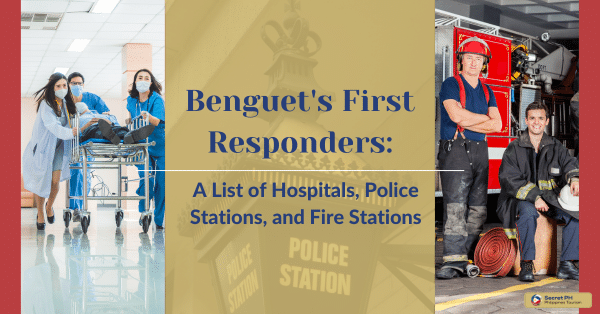To stay safe and prepared in the Philippines, it’s important to be familiar with the emergency services available in your area. Keep emergency numbers and important documents in a secure and easily accessible location. Have a first aid kit and emergency supplies on hand. Stay informed about weather conditions and any potential threats.
In this blog post, we will explore how to access emergency services in the Philippines and share some tips on how to stay safe and prepared in case of an emergency. So, whether you’re a tourist or a local resident, read on to learn more about how to stay safe in the Philippines.

Importance of Staying Safe and Prepared
Being safe and prepared should always be a top priority. An unexpected situations can arise at any given moment. Whether it is an emergency, natural disaster, or even a minor accident. Having the knowledge and tools to handle these situations can make all the difference. Being proactive in implementing safety measures and having an emergency plan in place can save lives.
It can also protect both individuals and their community. Take action by researching potential risks in your area, and creating an emergency kit. Practice evacuation procedures with family and coworkers. Remember, being prepared is not just a personal responsibility, but a responsibility to those around us.

Types of Emergencies in the Philippines
The Philippines is a country that constantly faces various emergencies. It ranges from natural disasters to human-made crises. With a location in the Pacific Ring of Fire and the Western Pacific Basin, typhoons, earthquakes, and volcanic eruptions are common occurrences. Sociopolitical issues like violence, terrorism, and health outbreaks add to the list of emergencies that Filipinos face.
Being aware of the types of emergencies that can happen in the country is crucial for both locals and tourists. Preparedness and readiness can make a big difference in saving lives. Also, it helps in minimizing the impact of these emergencies.

- Typhoons – Typhoons are among the most common types of emergencies in the Philippines. These powerful storms can cause significant damage to infrastructure, homes, and businesses. It can also disrupt transportation and communication networks. In addition to the physical effects, typhoons can also lead to loss of life and displacement of communities. The Philippines is particularly vulnerable to typhoons due to its location in the Pacific Ocean.
- Earthquakes – Earthquakes are one of the most common and perilous natural disasters in the Philippines. They are categorized by their intensity and can cause immense damage to infrastructure, property, and human lives. Earthquakes can be triggered by tectonic movements or volcanic activities. To prepare for earthquakes, individuals and communities must be familiar with proper safety drills. Knowing the procedures to follow when an earthquake happens can minimize the damage and save lives.
- Volcanic Eruptions – Volcanic eruptions are one of the most awe-inspiring displays of the raw power of nature. They occur when magma, gases, and ash are expelled from a volcano. It creates a catastrophic event that can have widespread consequences. The Philippines is no stranger to volcanic activity. With over 20 active volcanoes, the country is constantly at risk of volcanic eruptions. It can cause severe damage to property and loss of life.
- Fires – Fires are among the most common emergencies that occur in the Philippines. These disasters can be caused by a variety of factors. It ranges from faulty electrical wiring to natural disasters such as lightning strikes. When a fire breaks out, it can spread rapidly and cause significant damage to property. This can endanger the lives of those in the vicinity. It is important for individuals to be aware of the various types of fires. It includes electrical, chemical, and wildland fires, so that they can take appropriate measures to prevent and respond to emergencies.
- Accidents – The Philippines is no stranger to accidents and emergencies. From natural disasters like typhoons, earthquakes, and volcanic eruptions to human-caused incidents like transportation mishaps, fires, and building collapses. The country has faced its fair share of challenges. While gaining knowledge about these types of emergencies is crucial. It is equally important to learn how to respond to such situations. The key to staying safe during an emergency is to have a plan in place and to remain calm in the face of adversity.
Emergency Services in the Philippines
Emergency services in the Philippines encompass various organizations and agencies. They provide quick and efficient response to any kind of emergency situations. The Philippines’ emergency services primarily comprises of the Bureau of Fire Protection. The Philippine National Police, the Philippine Coast Guard, and the National Disaster Risk Reduction and Management Council (NDRRMC). These agencies are equipped with modern technology, equipment.
They are highly skilled personnel, committed to serving the people and responding to emergencies. This includes natural disasters, fires, crime, and medical emergencies. In addition to the government-run agencies, there are also private ambulance services available. It is to ensure that people get the medical attention they need during an emergency.
National Disaster Risk Reduction and Management Council (NDRRMC)
The National Disaster Risk Reduction and Management Council (NDRRMC) is the Philippine government’s primary agency for disaster risk reduction and management. It is a proactive and professional emergency response team. They are committed to minimizing the impact of disasters on the Filipino people. The NDRRMC is responsible for the coordination and management of disaster responses across the country.
They work closely with local government units, non-government organizations, and international partners. It is to ensure the safety and welfare of those affected by disaster situations. Thanks to the NDRRMC’s preparedness, the agency has been instrumental in reducing the number of casualties and damages caused by natural disasters in the Philippines. As the agency continues to evolve and improve, it remains a vital resource for the country’s emergency services.

Philippine National Police (PNP)
The Philippine National Police, also known as PNP, is the primary law enforcement agency in the Philippines. Composed of about 205,000 personnel, it serves as a crucial component in maintaining peace and order in the country. The PNP serves a variety of functions, ranging from preventing and solving crimes, to providing emergency services to those in need.
It plays a major role in ensuring public safety and security during times of natural calamities and unforeseen events, displaying their dedication and professionalism in serving the Filipino people. With its active and efficient response to emergency situations, the PNP continues to serve as a vital institution in the Philippines.

Bureau of Fire Protection (BFP)
In the Philippines, the Bureau of Fire Protection (BFP) plays a crucial role in providing emergency services to the public. With a focus on fire prevention and suppression, the Bureau’s well-trained officers work diligently to ensure the safety of citizens across the country. From providing fire safety education to conducting inspections of buildings and structures, the BFP is always actively working to minimize risks and respond to emergencies with speed and efficiency. With the support of the government and local communities, the Bureau of Fire Protection continues to be a vital component of emergency services in the Philippines.

Philippine Coast Guard (PCG)
The Philippine Coast Guard is an essential emergency service in the Philippines that plays a vital role in maintaining maritime safety and security. With its skilled and highly trained personnel, the coast guard ensures the protection of the archipelago’s vast coastline, as well as its marine resources. Its effective responses in search and rescue operations, environmental protection, and law enforcement have earned them an excellent reputation, both in the Philippines and abroad. Serving as the forefront of the national maritime defense, the Philippine Coast Guard remains committed to its mission of safeguarding the lives of the people, their properties, and the marine environment.

How to Stay Safe and Prepared
In today’s uncertain world, it’s important to know how to stay safe and prepared for anything that may come your way. Whether it’s a natural disaster, a sudden medical emergency or even a workplace safety issue, being prepared ahead of time can mean the difference between life and death. That’s why it’s crucial to have a plan in place that addresses potential hazards and outlines the steps you need to take to stay safe.
No. 1: Develop an emergency plan
Creating an emergency plan is a crucial step in staying safe and prepared for unexpected situations. Ensuring that you and your loved ones are aware of what to do during an emergency can make all the difference. Begin by identifying potential hazards and risks in your area and develop a contingency plan for each. Have an evacuation plan in place and make sure everyone in your household knows escape routes and a designated meeting spot. Stock up on necessary supplies such as food, water, and medical supplies.

No. 2: Establish an evacuation plan
Establishing an evacuation plan is vital for staying safe and prepared in case of emergencies. As the saying goes, failing to prepare is preparing to fail, and this applies especially in situations where your life is on the line. The first step is to identify the possible escape routes in your home, workplace or any other location you frequent. Once the routes are identified, it’s time to put your plan into action by organizing emergency supplies including food, water, first-aid kits, and flashlights. Also, ensure everyone in your household or workplace knows the plan and is ready to put it into action at a moment’s notice.

No. 3: Prepare emergency kits
When it comes to emergency preparedness, having a well-stocked kit ready can mean the difference between life and death. So how do you go about preparing an emergency kit? First, consider your needs. For example, if you live in an area prone to hurricanes or flooding, you’ll need to include things like waterproof containers, life jackets, and water purification tablets. If you live in an area prone to earthquakes, you’ll need to include sturdy shoes, a flashlight, and a battery-powered radio.
Once you’ve determined your needs, start gathering your supplies. Some essentials to including are non-perishable food items, bottled water, first aid supplies, and a multi-purpose tool. Be sure to also include any necessary medications, important documents, and cash.

No. 4: Stay Informed
Staying informed is a crucial step in keeping yourself safe and prepared. With the ever-changing landscape of the world, it’s important to stay up-to-date on the latest news and information. Whether it’s through local news sources, social media, or emergency alerts, you must be aware of any potential threats or hazards. In addition to staying informed, it’s essential to have emergency plans in place and necessary items such as first aid kits, food, and water readily available.

No. 5: Learn basic first aid skills
As much as we hope that accidents will never happen, it’s always better to be prepared. One of the best ways to prepare for emergencies is to learn basic first aid skills. By learning how to properly handle simple injuries like cuts, burns, and bites, you can potentially prevent them from becoming worse. Knowing how to perform CPR and how to use an automated external defibrillator (AED) can even save someone’s life.

No. 6: Know how to use fire extinguishers
Knowing how to use fire extinguishers can make all the difference in an emergency situation. First and foremost, it’s important to familiarize yourself with the different types of fire extinguishers and their corresponding classifications. In general, there are five types of extinguishers: A, B, C, D, and K. Each one is designed to combat fires caused by different materials, such as wood, gasoline, electrical equipment, and cooking oils. Once you’ve identified the type of fire extinguisher you need, it’s crucial to know how to use it properly.

In Conclusion
Staying safe and prepared during emergency situations in the Philippines heavily relies on the preparedness of the emergency services. By understanding the roles and capabilities of the emergency services, citizens can equip themselves with the right knowledge and tools to make quick and effective decisions during emergencies. It is important to keep updated with emergency alerts and ensure that emergency kits are readily available.
Moreover, keeping calm and following the instructions of the emergency personnel can greatly reduce the risks of injury and fatalities. By taking these steps, citizens can work hand in hand with the emergency services towards a safer and more prepared Philippines.








